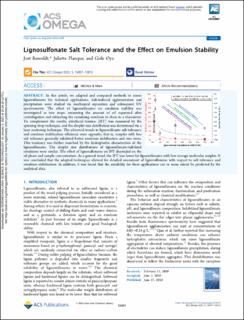| dc.contributor.author | Ruwoldt, Jost | |
| dc.contributor.author | Planque, Juliette | |
| dc.contributor.author | Øye, Gisle | |
| dc.date.accessioned | 2021-01-06T08:18:31Z | |
| dc.date.available | 2021-01-06T08:18:31Z | |
| dc.date.created | 2021-01-05T11:31:15Z | |
| dc.date.issued | 2020 | |
| dc.identifier.citation | ACS Omega. 2020, 5 (25), 15007-15015. | en_US |
| dc.identifier.issn | 2470-1343 | |
| dc.identifier.uri | https://hdl.handle.net/11250/2721621 | |
| dc.description.abstract | In this article, we adapted and compared methods to assess lignosulfonates for technical applications. Salt-induced agglomeration and precipitation were studied via mechanical separation and subsequent UV spectrometry. The effect of lignosulfonates on emulsion stability was investigated in two steps: measuring the amount of oil separated after centrifugation and subjecting the remaining emulsion to shear in a rheometer. To complement the results, interfacial tension (IFT) was measured by the spinning drop technique, and the droplet size distribution was determined via a laser scattering technique. The observed trends in lignosulfonate salt tolerance and emulsion stabilization efficiency were opposite; that is, samples with low salt tolerance generally exhibited better emulsion stabilization and vice versa. This tendency was further matched by the hydrophobic characteristic of the lignosulfonates. The droplet size distributions of lignosulfonate-stabilized emulsions were similar. The effect of lignosulfonates on IFT depended on the oil phase and sample concentration. As a general trend, the IFT was lower for lignosulfonates with low average molecular weights. It was concluded that the adapted techniques allowed for detailed assessment of lignosulfonates with respect to salt tolerance and emulsion stabilization. In addition, it was found that the suitability for these applications can to some extent be predicted by the analytical data. | en_US |
| dc.language.iso | eng | en_US |
| dc.publisher | American Chemical Society | en_US |
| dc.relation.uri | https://pubs.acs.org/doi/10.1021/acsomega.0c00616 | |
| dc.rights | Navngivelse 4.0 Internasjonal | * |
| dc.rights.uri | http://creativecommons.org/licenses/by/4.0/deed.no | * |
| dc.title | Lignosulfonate Salt Tolerance and the Effect on Emulsion Stability | en_US |
| dc.type | Peer reviewed | en_US |
| dc.type | Journal article | en_US |
| dc.description.version | publishedVersion | en_US |
| dc.source.pagenumber | 15007-15015 | en_US |
| dc.source.volume | 5 | en_US |
| dc.source.journal | ACS Omega | en_US |
| dc.source.issue | 25 | en_US |
| dc.identifier.doi | https://doi.org/10.1021/acsomega.0c00616 | |
| dc.identifier.cristin | 1865399 | |
| dc.relation.project | Norges forskningsråd: 269570 | en_US |
| dc.description.localcode | Copyright © 2020 American Chemical Society. This is an open access article published under an ACS AuthorChoice License, which permits copying and redistribution of the article or any adaptations for non-commercial purposes. | en_US |
| cristin.ispublished | true | |
| cristin.fulltext | original | |
| cristin.fulltext | postprint | |
| cristin.qualitycode | 1 | |

